All types of sturgeon are valuable commercial fish, the population of which is rapidly declining due to the regulation of river flows, hydro construction, land reclamation, illegal fishing and other negative factors associated with human activities. Attempts to increase their stock in nature have so far yielded unsatisfactory results. For these reasons, all types of sturgeon fish are listed in the international, and some also the Russian Red Book. In this regard, their breeding in artificial conditions (at fish factories, in artificial reservoirs, etc.) has become widespread.
Sturgeon species: photo and list
The sturgeon order is widespread in the water basins of North America, North Asia and Europe. There are both passing and semi-passing species, and freshwater. All of them are united by a long life cycle and excellent fertility, as well as a similar appearance, diet and lifestyle. Sturgeon species of fish, whose body structure resembles an elongated spindle, have 5 rows of bone bugs. Two are located on the sides and belly, and one on the back. Between them are small plates and bone grains. The dorsal fin is located closer to the tail, and on the underside of the snout you can see four antennae. The anterior ray of the pectoral fin resembles a thorn, according to the transverse cuts of which it is possible to determine the age of the individual.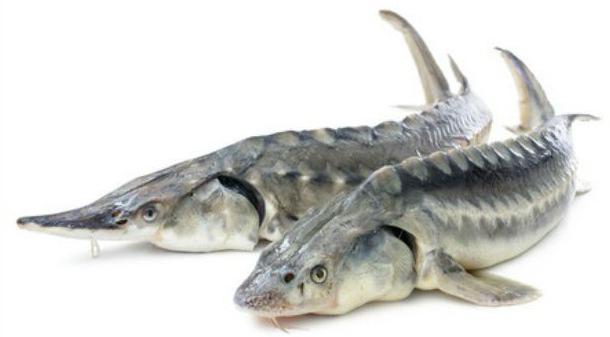
In the territory of the former USSR, sturgeon species of fish live, the names and photos of which are presented below:
- Beluga
- Kaluga
- shovel;
- sterlet;
- spike;
- stellate sturgeon;
- atlantic sturgeon;
- Pacific (Sakhalin) sturgeon;
- Russian sturgeon;
- Persian (South Caspian) sturgeon;
- Amur sturgeon;
- Siberian sturgeon;
- three pseudopatonos (large, small and Fedchenko).
The sturgeon family is divided into two subfamilies: sturgeon-like (beluga, kaluga and all sturgeons) and spade-like (American shovelnose and pseudopatonas). All representatives of sturgeons have a cartilaginous structure of the skeleton, in which there are no vertebrae, and the chord is preserved until the end of life.
Sturgeon family: fish species and their features
In addition to the main species, there is a wide variety of hybrid varieties, since they easily form hybrids, crossing in places of spawning grounds. Regardless of the species, fish spawn only in rivers with a fast flow and oxygen-saturated water, the bottom of which is strewn with pebbles, stones and sand. The sturgeon breeds several times during its life (but not every year) at a temperature of 15-20 ° C, so only the spring-summer period is suitable for this.
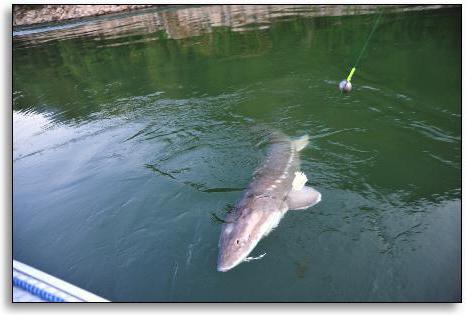
Young growth of migratory representatives (stellate sturgeon, beluga, Russian and Atlantic sturgeon, spike) leaves after leaving eggs in the mouth areas the same summer as adults, but some of the fingerling and Russian sturgeon may linger in the river for a year or more. The roomy yolk sac available in fry contains nutrients, due to which they live the first time. After its resorption, they start self-feeding: they first eat planktonic crustaceans (daphnia and cyclops), and then go on to gammarida, mysid, chironomid larvae and oligochaetes.
Passing sturgeon species are divided into winter and spring forms within each species, the degree of differentiation of which depends on the size of the river: both forms are pronounced in large water flows (for example, the Volga and the Urals), while smaller forms are dominated by spring, inferior in size to winter. The latter, for spawning, enters rivers from the end of summer and in autumn, rising high, winters in pits, and spawns in the spring of next year.The spring race rises into the rivers in early spring, but not high, and begins to multiply immediately, reaching spawning grounds.
Beluga
The largest representative of sturgeons, whose length can reach 5 meters and weighs more than 1 ton, lives the longest - up to 100 years. Archaeological finds of medieval Belugs are known, the size of which exceeded 6 m. Fishermen of that time often died when a similar giant fell into their gear.
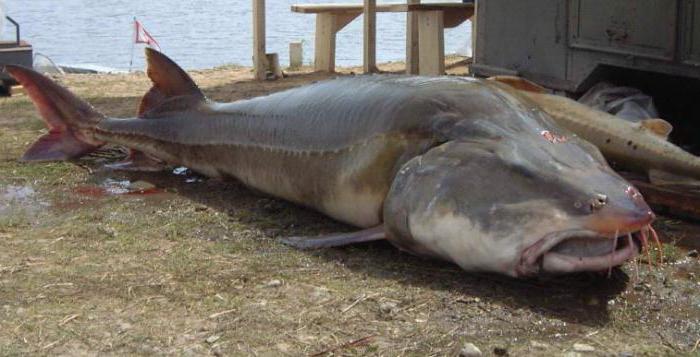
There are Black Sea and Azov subspecies, which, like all migratory species, also have winter and spring forms, prevailing depending on which river the population spawns in. The Azov individuals reached maturity earlier - females at 12-14 years, and males at 16-18. The remaining species are much later - 14-23 and 17-26 years, respectively. Beluga is the most prolific fish. The largest females toss eggs up to 7.7 million pieces
Kaluga
Belongs to the largest freshwater fish. Its length reaches 3.7 m, weight - 380 kg, and this representative of the fauna lives up to 55 years. The sexually mature kaluga is getting very late: males - at 17-18 years old, females - from 18 to 22 years old. Fish is extremely prolific: sometimes the number of eggs reaches 4.1 million. By the way, the types of sturgeon caviar are different: lumpy and granular. So in kaluga it reaches 4 mm in diameter. There are two forms of this giant: the estuary is fast-growing (a semi-aisle form, spawning in the Amur River) and the river, smaller, forming local little moving herds in the river.

This is a pronounced predator: the estuary form eats salmon (chum, pink salmon) when they go to spawn in Amur, but because of the decrease in their number, kaluga is seen in cannibalism. The river subspecies eats small bottom fish such as minnows.
Sterlet
The smallest freshwater representative of sturgeons: reaches 1.2 m in length and up to 16 kg of weight. The sterlet has the largest number of lateral bugs (more than 50) and fringed antennae, which distinguishes it from other sturgeons. Another feature of this fish is the variable shape of the snout, which is why two forms are distinguished - pointed and blunt. The latter grows faster, more well-fed, has more fertility than a sharp-headed relative. Such a difference is inherent in other freshwater sturgeons - Amur and Siberian.
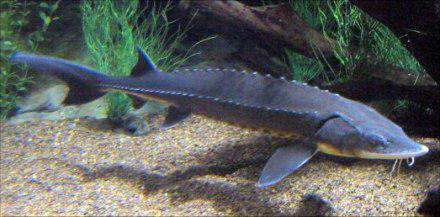
Males become capable of breeding at 4-5 years, females at 4-9. The number of eggs depends on the size of the females, as in other sturgeons, and reaches a maximum of 140 thousand pieces in the Volga, the largest sterlet.
Stellate sturgeon
Like all types of sturgeon, it has distinctive features: it is easy to identify by a very long snout (over 60% of the head) in the shape of a sword. This is a passing species in which the spring race dominates, reaching 2.2 m in length and weight 80 kg. The most heat-loving among migratory species, in connection with which it spawns later than others, when the water temperature is more suitable (spring run at 10-14 °S, autumn - 13-17 °WITH). Males mature in 8-11 years, and females from 10 to 14. The population of Azov stellate sturgeon grows more rapidly and matures earlier. The most prolific fish is the Ural. She tosses up to 743,000. Eggs.
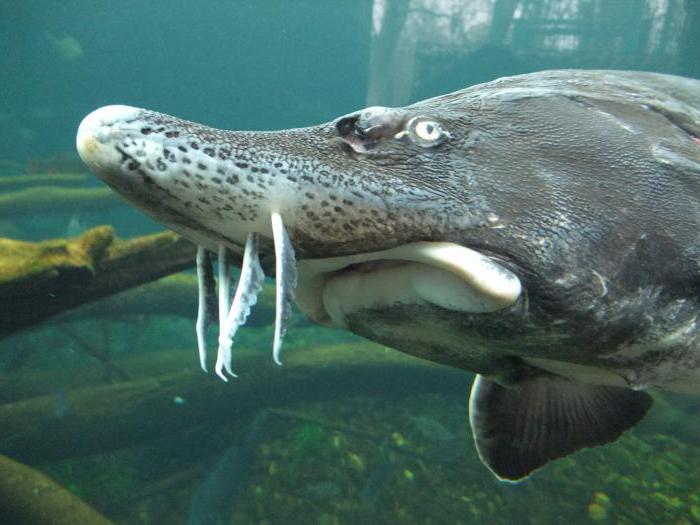
Having finished spawning, immediately, not lingering in the river, he swims into the sea, where he eats Nereis and crustaceans. It ranks first in the sturgeon fishery. Most stellate sturgeon is mined in the Urals.
Atlantic sturgeon
This is a large migratory sturgeon, reaching 3 m in length and weighing more than 200 kg. He has massive bugs on his body with a radially striated surface, and in the pectoral fin there is a powerful bone ray. Unfortunately, the once-large population today numbers about 1 thousand individuals that live in the Black Sea basin.
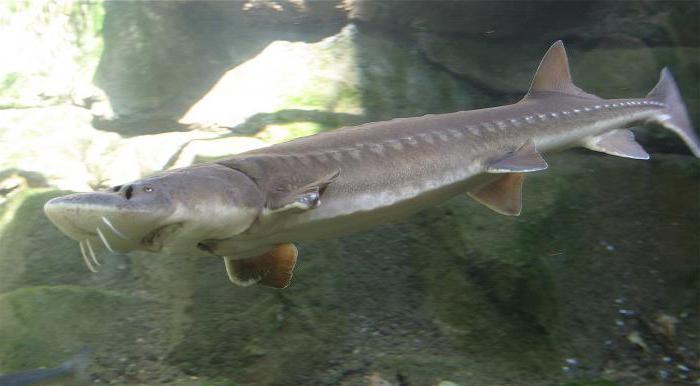
Males reach reproductive age at 7-9 years, and females from 8 to 14. Fertility is estimated at 5.7 million eggs. Without lingering after spawning, the fish leaves quickly in the sea, where its main diet is hamsa. All types of sturgeon are of commercial value.
Russian sturgeon
Among sturgeons, Russian is the largest in number.Its distinctive features are a short blunt snout and antennae without fringes, sitting closer to the edge. The fish grows to 2.3 m, reaches a weight of 100 kg. It has difficult differentiated varieties of spring and winter forms that go to spawn in different periods. They have different sizes, growth rates, duration of stay in fresh water.
The Caspian representatives of the Russian sturgeon reach a mature state at the age of 12-13 - males, and at 15-16 - females. The Azovs are growing up earlier - at 8-11 and 11-15 years, respectively. Like other sturgeon species, the Russian is very prolific: one female can produce up to 880 thousand eggs. Most of the fry go to sea, and some may remain in the river for 1-2 years. The favorite food of this species is mollusks. The fish also feeds on shrimp, crabs, and nereis.








